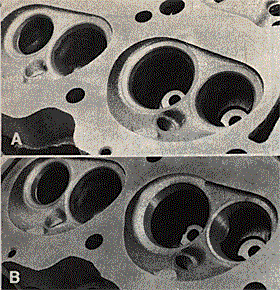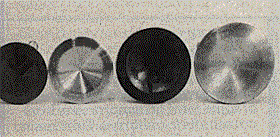To most people, mentioning Buick and performance in the same breath might seem like a contradiction in terms. Like military intelligence. Or jumbo shrimp. Fact of the matter is, during the "factory fast" era, Buick produced some real "bad actors" of their own. On the street and strip, more than a few Chevys, Fords, and Mopars had to settle for second billing after having their doors blown off by an "old man's" car. What's even more surprising is that Buick was able to do so with the same basic ingredients found between the frame rails of its staid, accessory laden Rivieras and Electras.
At the time, Buick's performance flagship was the Skylark Gran (no "d," please) Sport:
Of course, there are always those who believe no matter how good something might be, there is always room for improvement. Even as
We've assembled three examples of Flint's fines, ranging from a sedate 13.10 - second grocery getter ( with A/C and power windows, no less!) to a wild, wheel standing Pro Street capable of running 10.40's at will with a single 4-barrel! While the owners of these three trouper may be hundreds of miles apart, what really counts is that their heads are all in the same place - getting their Buicks' acts together!


Just looking at Kenny's Gran Sport, you'd probably find it difficult to believe it runs as hard as it does. Its pristine exterior also belies the fact that it has more than 160,000 well traveled miles under its belt - without any major rejuvenation!
With full power and A/C, Betts' GS certainly seems better suited for comfortable cruising than a serious boulevard workout. It's a sleeper in the truest sense of the word. Even a Glimpse under the hood reveals nothing out of the ordinary; no nitrous - not even an aluminum intake or headers detract from its box - stock image.
The real secret to Kenny's success is a careful blending of factory and aftermarket pieces that team up to boost his Buick's performance. Of course, when you start out with the Stage I package, you're one up on the competition already; it comes factory - equipped with cold - air induction, more cam timing, and better heads. Still, it takes some serious muscle to hustle two tons of sheet metal through the quarter - mile in just over 13 seconds, so Kenny added an even hotter Kenne-Bell MKC 118
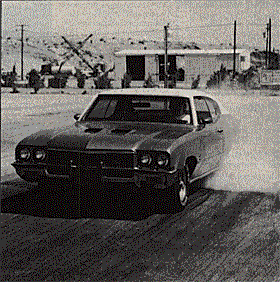
cam and kit, K-B oil pump kit, and Switch Pitch Turbo 400 transmission to round out his performance building program.
Even though the engine had traveled more miles than it had a right to (and was admittedly on the "loose" side), we were curious to see what kind of performance might be expected from such a mild combination. After bolting a set of 9 - inch slicks to the 3.90 - geared rear end, our first pass as Los Angeles County Raceway netted a corrected 13.30 at 105 mph. Not bad, but we felt there was more performance yet to be found. Next pass we removed the accessory drive belts, and realized an immediate gain of one tenth with no increase in trap speed. Finally, after letting the engine cool, we left the belts
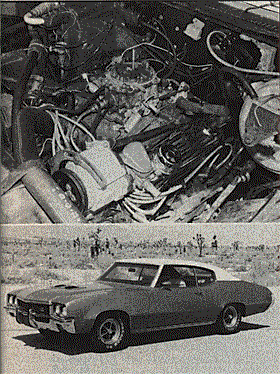
off, removed the air cleaner, and made on last banzai pass. The clocks stopped at a corrected 13.14 seconds with a speed of 106.6 miles per hour!
Considering this is a docile combination that is virtually unbreakable (how many cars do you know of that are even alive after 160,000 miles?), economical (less than $1000 above vehicle cost was spent to achieve this performance), and comfortable, wouldn't you really rather have a Buick?
Remember how we told you that the 455 was responsive to traditional power producing procedures? Well, Rick Lasseter's Stage I Gran Sport is probably the foremost example of what can be done with only a few basic bolt-ons and a lot of fine tuning. It's low 12-second time slips reflect a 15-year association that transcends most relationships between a special car and its original owner.
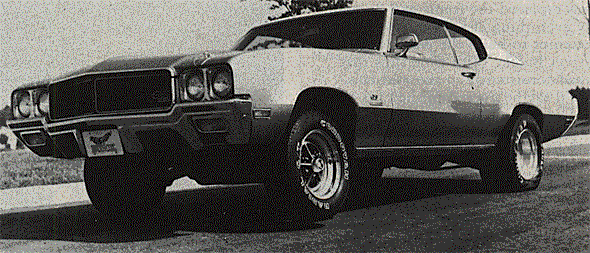
Lasseter isn't the type of person you'd normally expect to find in the staging lanes of your local drag strip. By profession, he's a physics and chemistry teacher in Valdosta, Georgia. He's also the president of the Gran Sport Club of America. When you stop to think about it, maybe that isn't such an unlikely combination.
Rick is a true believer in the club's motto, "Go Fast With Class", and has been quite successful at parlaying some of his scientific knowledge into making his Gulfstream blue Buick run much harder than it has a right to. He doesn't rely on any trick equipment or horsepower through chemistry
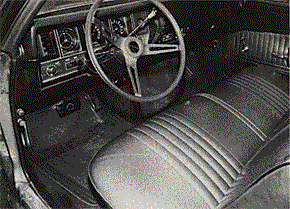
(although you might expect him to do just that) to achieve his phenomenal results. Instead, only a combination of realistic components and methodical testing have allowed him to knock on the 11-second door without sacrificing day-to-day driveability.
Rick's power plan began with an engine rebuild at 60,000 miles (the clock now shows over 90,000). Forged 10.25:1 pistons from Sealed Power replaced the stock slugs for the sake of reliability, while a Kenne-Bell cam (ground on 118-degree lobe centers for a smooth idle) and related
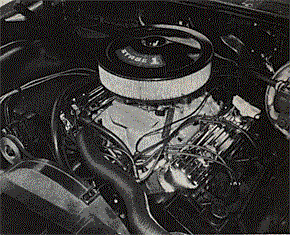
valve train components were added to enhance the breathing characteristics of the already stout Stage I package. The rest of the engine's internals are stock, attesting to the reliability of OEM Buick components. Hardware changes on the engine's exterior are more evident, however, and include an Edelbrock B4B intake, a 750 cfm Holley, a Hays Stinger ignition, and Mickey Thompson headers dumping into a pair of Cyclone Sonic Turbo mufflers.
That's it. Even the original 3.42 gear remains in place, though it is practically a necessity - Lasseter drives his GS 130 miles one way to Gainesville (Florida) Raceway for testing and an occasional bracket bash. Uncorked and with a set of 11-inch slicks in place, Rick's 3900-pound Buick turns low 12's, with a best time to date of 12.01 seconds. Then, after a night of blowing off the competition, Rick simply bolts on his street tires, adjusts the tilt wheel , tunes in the AM/FM stereo, and boogies back to Valdosta, averaging 15-miles-per gallon on the return trip home.
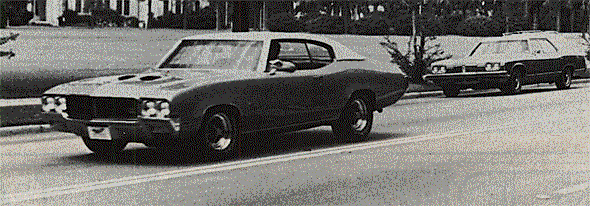
Rick's dual-duty GS proves that you can easily race (and run 12's) on Sunday, then bolt up the exhaust and drive it to school on Monday.
Who says you can't have performance and enjoy it too? Lsseter's GS could sure make a strong case for that line of thinking. But then again, Rick believes in "Going Fast With Class".
If the preceding two cars were somewhat less than exciting in terms of visual impact, then Mark Busher's fiberglass-fendered flyer ought to appease the appetites of those who crave outrageous machinery - from both the visual and performance standpoints. Still, it represents a homebuilt super car in every sense of the word; but how many 10-second performers do you know that see regular street duty?
Busher's Buick came into his possession some 10 years ago, as an ex-racer with a cracked frame and a non-existant power train. Since then, Mark has replaced the frame and "practically everything else on the car," in an attempt to build the world's quickest street Buick. With time slips that read consistently in the mid-10's, we'd say he's accomplished his goal.
Did we tell you that this 10-second wonder has been a complete backyard wonder has been a complete backyard affair? As a family man, Mark knows well the value of a dollar saved by doing the work yourself. In fact, his won handiwork can be noted everywhere from the narrowed
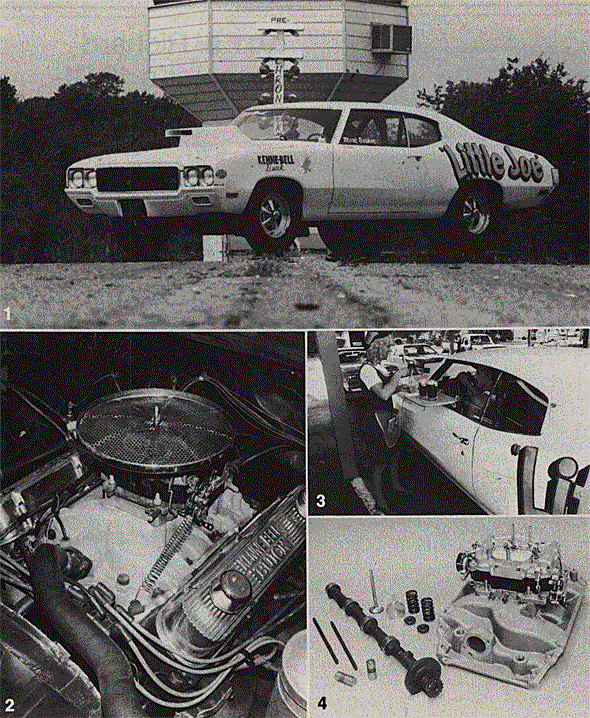
1. Busher's GS may look like a race car, but it's docile enough to be driven daily on the street. An hour-long cruise never saw the temp gauge above 180 degrees, although the fuel gauge was considerably more active!
2. No tunnel ram or laughing gas needed here, Just an Edelbrock intake and a 1000 cfm Thermo-Quad get this Buick into the 10's
3. A stop at the local A&W turned a few heads, but the waitress bought us our root beers anyway.
4. Getting to the heart of the matter: A Kenne-Bell valve train teams with an Edelbrock/Carter combo to make lots of horsepower!
frame rails, to the appropriately widened Cragers shod with DOT-approved Mickey Thompson rubber. Busher also builds his own engines - with machine work performed by Hines Racing Engines and has recently begun building engines for other Buick enthusiasts.
Getting most combinations into the 10's usually requires not only a radical power plant, but extensive lightening as well. Surprisingly, Busher's hasn't needed either. Oh sure, the front end is a rare fiberglass piece, and the interior isn't as comfortable as some Buicks we've seen, nevertheless, both doors are the original steel pieces (with factory glass) and the rear deck lid is all metal, and latches just the way the factory intended it to. Underneath, a 4.56-geared, standard width Chevelle 12-bolt is held in place using an SRD ladder bar setup. Once again, Mark accomplished all the is in his own garage.
Turning to the engine, nothing out of the ordinary is noted; only common sense horsepower techniques and the use of generally available components. A standard 455 block was first bored .010-inch, then fitted with Kenne-Bell Superlite 11:-1 forged pistons and Speed-Pro moly rings. It's no secret that cam choice is critical on any stout-hearted street runner, and for his purposes Busher chose a K-B Mk5H with complementary valve train components. According to Mark, "power with this cam is awesome from 4000-7000 rpm." For heads, Stage I castings were treated to a homespun porting job and fitted with swirl-polished Stage I valves. The rest of the engine's
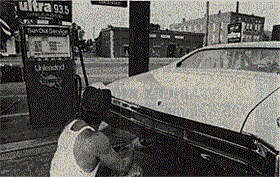
Mark is able to run his ground-bound missile on pump gas, though best results are obtained with racing fuel. Sunoco doesn't peddle 260 any longer, but the 93.5-octane unleaded seems to get the job done!
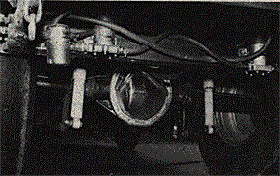
Dual Holley electric pumps feed the voracious big-block; a stock - width 12-bolt with 4.56 gears pirated from a a Chevelle plants the power.
internals were left basically stock, but carefully balanced before assembly.
Mid-10's through a single 4-barrel is no mean feat, but the secret here seems to be in the carburetion. Certainly the B4B Edelbrock doesn't pose an inlet restriction, and when fitted with a 1000 cfm Carter Thermo-Quad seems to provide all the air and fuel the engine requires. On the exhaust side, K-B headers and Cyclone Sonic Turbo mufflers keep the exhaust gas moving better than most, while still providing ample noise suppression. Mark also chose a K-B Switch Pitch Turbo 400 with a 3500- rpm stall converter to get his 3100-pound behemoth launched consistently
As you can see, Busher's success with his 10-second street missel is something that could be duplicated rather easily - and without having to promise your first born to the prince of darkness. As home built super cars go, we think you'll agree that Busher's Buick is more super than most!
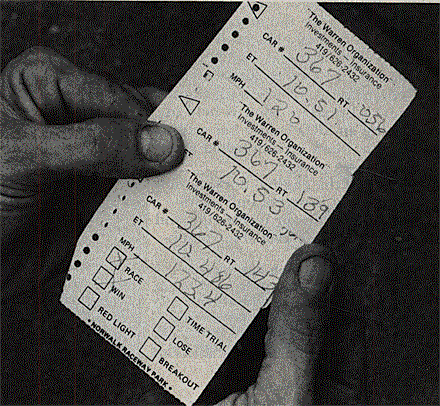

If you already own a Buick and would like to boost its performance with a set of Stage I heads, here are the casting numbers to look for:
| 1970 | 1240150 |
| 1971 | 1240146 |
| 1972 | 1238530 |
| 1973-74 | 1242002 |
These heads might not be the easiest to locate, so be prepared to come home empty-handed if your junkyard forays prove unsuccessful. Since the standard and Stage I castings are essentially the same, your best bet might be to latch on to a set of standard heads, send them to Kenne-Bell for the necessary machine work, then outfit them with Stage I valves. The valve numbers are as follows:
All years:While you're at it, you may as well install the Stage I valve springs too, available under PN 1383851.
